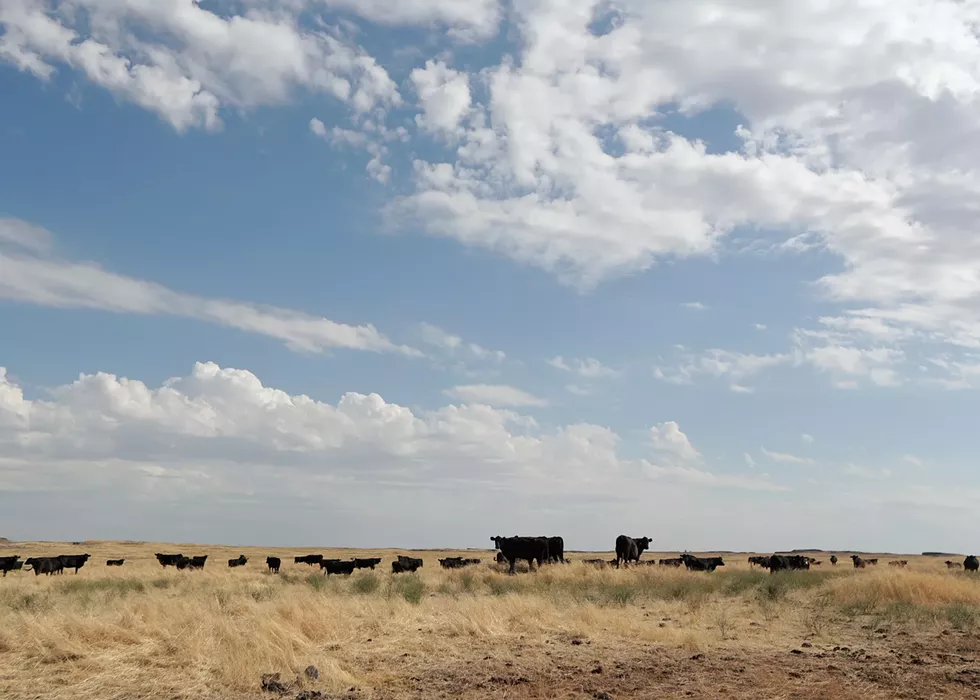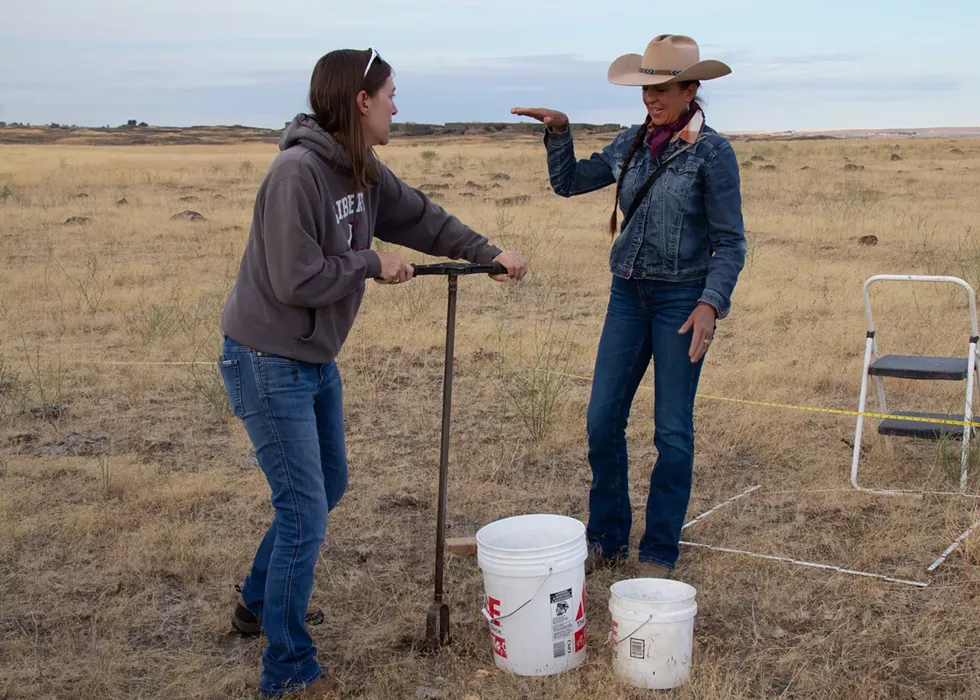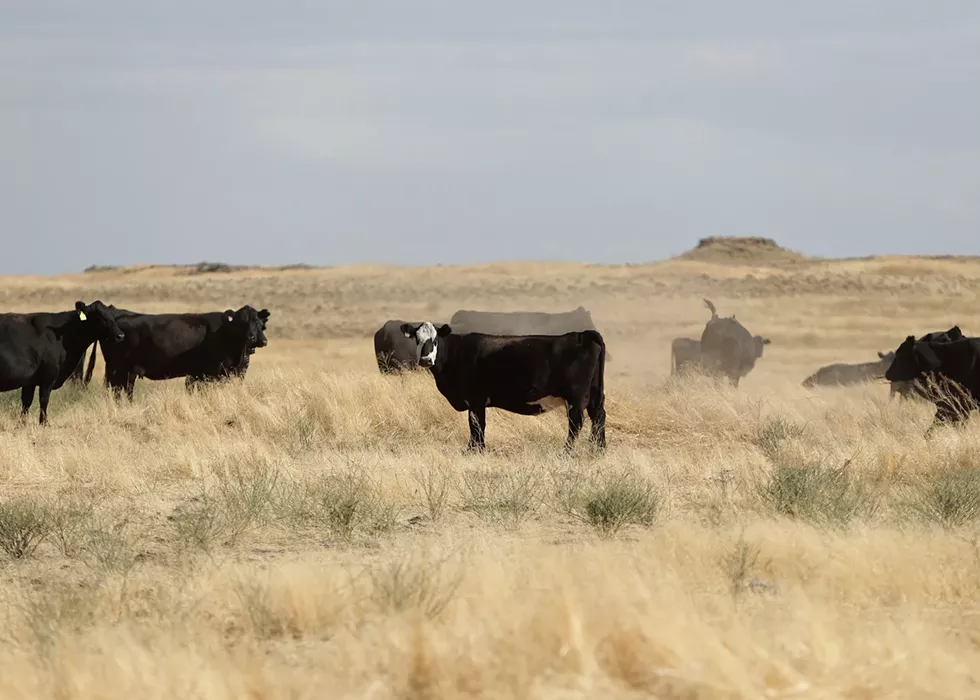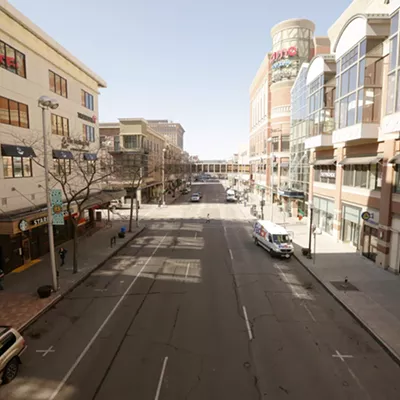
It's 7:30 am and the sun is finally warming up a chilly September fog.
Just west of Sprague, Washington, a wide pasture is empty, except for a white pickup truck snaking its way across the dead grass. The truck stops at a random spot, a few yards away from a bleached cow skull. It must have been here for years now, bright bone against black basalt à la Georgia O'Keefe.
Three women get out of the pickup, one in denim and a cowboy hat, another in plaid, another in a sweatshirt and ballcap. They unload modest supplies — an iPad, a measuring cup, a plastic bucket and a well-used folding ruler.
"Every time we do this, the rancher becomes an ecologist," the woman in the cowboy hat says.
Her name is Anna Clare Monlezun. She's a Colorado rancher, a rangeland ecosystem scientist and an independent contractor with Northway Ranch Services, a Wyoming-based company that provides technical support for ranching operations across the West. Today, she's in Sprague with Courtney Thompson and Danielle Harder, sisters and fourth-generation ranchers at Golden West Cattle Co.
More than a decade ago, Thompson and Harder's father, Rex Harder, joined Country Natural Beef, a rancher-owned beef cooperative with over 100 members across the western United States. The family ranchers in the co-op use land-friendly practices that are intended to raise better beef and protect and improve the land the cattle graze on.

Today, Monlezun, Thompson and Harder are going to start quantifying to what extent that is true.
Country Natural Beef is partnering with Northway Ranch Services and Sustainable Northwest, a nonprofit dedicated to creating climate solutions across various industries, to create a proven regenerative ranching program called "Grazewell." Ranchers outside Country Natural Beef are also invited to join. With the help of federal dollars from the Climate Smart Commodities grant, they're enlisting ranchers, ecologists and data analysts to prove that nontraditional ranching techniques can make cattle helpful — not harmful — to the environment.
The idea for all participants is that if cattle are allowed to graze more haphazardly and rotated more frequently, the animals can work within an ecosystem to improve soil health and plant biodiversity.
The benefits of healthy, diverse plants are wide-ranging: Herds produce higher yields of more nutritious beef, the soil sequesters more carbon, and rangelands are more resilient in the face of extreme weather events.
These are big, bold claims for any industry, much less the cattle industry, which has gotten a bad environmental reputation due to methane emissions from the animals themselves and the amount of water and plant life it takes to make a hamburger.
"Cows do contribute to climate change more so than a lot of other areas in agriculture," says Amy Harder, one of Rex's other daughters who grew up on the ranch and went on to cover climate issues for the Wall Street Journal, Axios and now Cipher, a news outlet sponsored by Bill Gates' investment platform and thinktank Breakthrough Energy. "Beef is far more climate-intensive than any other meat. So the emphasis on beef is important."
Country Natural Beef, which is sold at Huckleberry's Natural Market on the lower South Hill, wants to beef up its claims of land conservation with real data. So the co-op has asked its ranchers to work with people like Monlezun to set up monitoring sites across their rangeland. Each site will gather data on soil composition, plant diversity, plant density and water infiltration.
"Those are the indicators that we can see above ground that are telling us if we're likely sequestering carbon or not," says Dallas Hall Defrees, the regenerative ranching program director for Sustainable Northwest. "If we're getting more biodiversity, if our water infiltration is better, it's likely that the plants above ground are creating bigger root biomass and converting the atmospheric carbon into soil organic carbon."
The data will be sent to Texas A&M University, where researchers will try to estimate the amount of carbon sequestered by each area of rangeland. Other data will go to Quantis, a private company that runs life cycle analyses of different greenhouse gases, including methane.
The hope is that within five years, ranchers in the Grazewell program will be able to prove that they are managing their herds in a way that improves their land and contributes to global decarbonization.
"I think they're some of the most progressive ranchers in the world as a unified group," Monlezun says.
'IT'S JUST NATURAL'
Rex Harder's family has been ranching near Sprague for about a century. The third-generation cattleman was drafted into the Army in 1969, spent five years bouncing between Oklahoma, Vietnam, Germany and Texas, and then came back to Eastern Washington and attended Gonzaga University to become a certified public accountant. He was a CPA for almost two decades before finally taking over Golden West Cattle Co. in 2000.He's tall and lean, careful and warm when he speaks, and modest about his expertise and the major cattle operation his family has grown. He's naturally interested in biodiversity and protecting the land.
"That might be a hawk," he says, pointing up at a raptor circling overhead. "I think if you have wildlife and fish and other natural animals, you're really not totally disturbing the pasture and the rangeland."
The entire Harder family has intimate knowledge of thousands of acres of land. They can find old roads overgrown with grass, well-trod cow paths otherwise only known to their herds, and the biggest bunches of sagebrush or the lowest swaths of grass.
"Ranchers and farmers are working and living so close to the earth, literally touching the dirt," Amy Harder says. "Their office is the pasture. It's just something that has been inherently embedded into this type of life, in a way that so many of us otherwise take for granted."
Rex inherited land that was deeply changed by management before him, going back even further than his family. The land was originally ranched by owners of the Hercules silver mine in North Idaho, who imported Scottish shorthorn cattle from Europe.
At the beginning of the 20th century, common ranching practices left cattle on a piece of land for as long as possible, Monlezun says. Feed left in the field was considered money left on the table. Overgrazing suppressed native plant life, and any plants that weren't food were considered undesirable and sometimes burned.
"We didn't understand rangelands very well," Monlezun says. "So our policies and our management guidelines that came out of science and government were misleading. That's the root of that bad reputation. So nowadays, we're ranching on lands that carry a lot of baggage, that basically have these long histories of mismanagement and lack of ecological knowledge that maybe our Indigenous peoples understood way better than we did."

New studies are showing that sagebrush, previously considered undesirable because cattle don't eat it, draws a lot of water up and spreads it laterally to other plants. Even though most herbivores don't eat sagebrush, it ends up being very beneficial to them.
Large herbivores are no strangers to this land. Huge herds of buffalo, bison, elk and deer used to be major players in the truly wild West. Their presence and appetites are actually essential to the health of Western rangeland, Monlezun says.
"Fire, drought and herbivory — in other words, grazing by large herbivores — are the three 'disturbances' that maintain grassland ecosystems," she says. "So what a lot of research has worked to understand is, 'Can we manage cattle in a way that mimics nature and the large wild herbivores that used to be here?' That's really the premise of this entire thing. We look at their dynamics with water and plant biodiversity and soil, and we try to mimic that with our grazing management of domestic herbivores, like cattle and sheep."
Rex joined Country Natural Beef about 15 years ago because he was able to sell his product at a higher price to people who cared about how the land and animals were treated. Plus, the co-op's goals to learn more about rangeland management and implement better techniques seemed more than reasonable to him.
"You're closer to the customer, and there's a premium," he says.
He says he's happy that Grazewell is trying so hard to responsibly manage lands and back up their claims.
"For some people, it's just natural," Monlezun says. "This is not an age or generation thing because I meet old ranchers who for them, it's just common sense."
PERENNIAL PASTURES
Buzzwords like "regenerative ranching" and "carbon sequestration" and "ecosystem synergy" might be sexy, but the actual data collection is not.As the temperature creeps into the 80s for a sunny September afternoon on the range, Monlezun shows Rex's daughter Courtney Thompson how to use a T-shaped "sod plugger." They take turns digging out plugs of soil from 10 centimeter and 30 centimeter depths. She uses her phone to time how long it takes for a cup of water to fully soak into the ground. Then she takes a picture with the iPad of the area's groundcover, which she uploads to a data collection hub.
But Thompson, who's also the county planner for Lincoln County, is game for anything.
"I like this kind of stuff," she says when Monlezun apologizes for a less than glamorous morning.
They repeat the tests a total of three times at intervals 20 feet apart from each other.
Then, Monlezun crouches close to the ground and starts combing her hand through the yellow grass. To an untrained eye, it looks like one clump of the same dead stems. But Monlezun is able to separate out invasive annual grasses from native perennial grasses, plus a few native wildflowers called forbs. She points at one plant with a long stem and a narrow row of seed pods.
"Sandberg's bluegrass — this is one you want to see more of," she says to Thompson and her sister. "This is your major native species here."
When Monlezun visits ranches, she mainly talks about plants. Plants are ranchers' friends, she says. Plants feed cows, cows produce beef, and ranchers sell that beef. If you look at it a certain way, ranchers are essentially grass farmers.
The thing is, not all grasses are created equal. Annual grasses — that is, grasses that grow one year and die — are often invasive species from Asia or the Mediterranean. They're opportunistic, which means they pop up quickly from shallow roots, use up a lot of nitrogen, drop a lot of seeds, and die.
They're great at spreading. But that's about it.
Perennial grasses, however, are the opposite. They return every year, take a bit longer to grow and have stronger, deeper root systems. They're great at providing nutritious forage, protecting the land from erosion, taking more carbon out of the air and storing it deeper underground, and adapting to their native environment.
"Plant communities need a little bit of everything," Monlezun says. "We do wanna see some annual grasses, some perennial grasses, some annual forbs, some perennial legumes. That's ideal. But what we see a lot, unfortunately, in Western rangeland is an overabundance of annual grasses."
If you want to give your cattle more nutritious wild food, be more resilient through drought and regional weather events, improve soil health, protect from erosion, and sequester more carbon, it basically all comes down to having more perennial plants.
Ranchers can encourage the growth of perennial grasses by grazing their herds in different pastures at strategic times — that is, if they know enough about which plants are growing in which specific micro ecosystems.
That's where a visit from a rangeland ecology scientist comes in. Monlezun helps Thompson and Harder identify the main grasses in their pastures. They spot a whole lot of cheatgrass and Medusa's head, which are annuals that are invasive all over the U.S.
As they leave their first monitoring site, the three women leave red markers so they can come back and monitor the same site five years from now. They start talking about how the pasture could improve in the meantime. The water infiltration is good, the soil composition is standard for this part of the country, and the ground is mostly covered by plants. Perhaps just not the right ones.
The hypothesis is that the more healthy the land is, the more healthy and productive your herd is gonna be.
"Your biodiversity is what we can focus on," Monlezun suggests.
Instead of cheatgrass, these pastures should have more Sandberg's and squirreltail grass, plus flowering plants like yarrow, fireweed and mustard, she tells them. To get more of those plants, Golden West will have to switch up their grazing patterns so the herds aren't eating in the same pasture at the same point in the growing cycle every year.
For example, if cattle start grazing in pasture A in the spring, then move through pastures B, C, and D throughout the summer, it would be ideal to start them the next spring in pasture D, then move backwards through C, B, and finally A.
Bouncing back and forth in what some ranchers imagine as a horseshoe pattern instead of a circle gives more perennial grasses the chance to mature. They might also have to move herds off land more quickly to leave some plants uneaten — which is antithetical to common ranching techniques — so that some slow-growing perennials are spared.
If this sounds simple, you've probably never moved a few thousand head of cattle to a new pasture miles away or had to negotiate grazing agreements with state land agencies. More movement is exponentially more work for ranchers. But there are both environmental and economic incentives for them.
"The hypothesis is that the more healthy the land is, the more healthy and productive your herd is gonna be," Monlezun says.
A richer, healthier diet could mean less money spent on supplemental feed and vet visits. It could also mean more meat per cow (especially during years with less rainfall) that can be sold at a higher price to consumers.
"It's like a salad bar," Defrees at Sustainable Northwest says. "Humans don't just need the iceberg lettuce. You wanna add carrots and celery and raisins to your salad as well because they provide different nutrient benefits. A lot of the time, cows gain better on [biodiverse land], and they have healthier immune systems. In some instances, producers can actually increase the amount of cattle they have on their land because it's performing better."
What's more, healthy soils and plants don't just benefit carbon footprints and cows — it can benefit the people eating the burgers, too.
"The more biodiverse and healthy the soil, the more biodiverse and healthy the forage that the cattle eat, therefore the meat that we are eating from that animal is more nutrient dense and diverse than meat that comes from being fed a more simplistic diet," Monlezun says. "So that's feeding our nutrient needs as humans."
And, of course, there's always the undeniable and unquantifiable joy of finding a plant you had no idea still grew in your pasture.
"Wild onion!" someone shouts from farther downfield.
"Oh, no way!" Danielle Harder shouts back.
DECARBONIZATION AND DIVERSITY
Danielle Harder has been quietly observing Thompson and Monlezun all morning while also taking a call from the western side of the state. She's a mechanical engineer by education, supply chain expert and entrepreneur by trade, and currently the vice president of strategy and operations for Scope 5, a division of Environ Energy that helps companies track carbon and emissions date.She visits home often and is intrinsically interested in happenings at the ranch. She wishes the group was on horses instead of in a pickup. But she's also interested in the data collection project because of what it could mean for the tech world in the future.
"As our markets start driving decarbonization, that's going to be beneficial to the agricultural system," she says.
If ranchers and farmers can prove how much carbon their land sequesters, companies like Microsoft and Amazon that have pledged to become carbon neutral or carbon negative could buy carbon credits from these landowners to offset their carbon emissions.
Purchasing those credits could be a new stream of income for food producers. It's another financial incentive that could promote land management that prioritizes healthy ecosystems.
But the carbon credit market needs data. The Grazewell program is in the embryonic stages of collecting and verifying that data, Harder says. She's excited to watch it happen in real time.
She's also eagerly awaiting the results of the greenhouse gas life-cycle studies that will eventually come out of the program. Preliminary research from Utah State University shows that more nutritious diets can reduce the amount of methane that cows release during digestion, which could be one more reason perennial plants are great for the planet.
Ranchers and farmers are working and living so close to the earth, literally touching the dirt.
Cow burps aside, grasslands cover about 40% of the Earth's land surface. The U.S. Department of Agriculture's Forest Service estimates that rangeland covers about 770 million acres of the country.
Restoring that land to a healthier, more carbon-sequestering ecosystem is imperative in improving climate resiliency, and it's going to take cooperation from many different sectors and lots of different ranchers.
"I look at diversification of the people that are in this group," Rex Harder says, referencing even the different careers and expertise in his own family. "They're all owners. They're diversified by their education. We don't need the same cowboys that we needed back then. The tasks have changed. I'm looking at [the ranch] in the past and what we did. But they need to think about the future. What are they going to do? How are they going to do it? Because it's absolutely not going to be managed the same way in the future that it was in the past." ♦

















